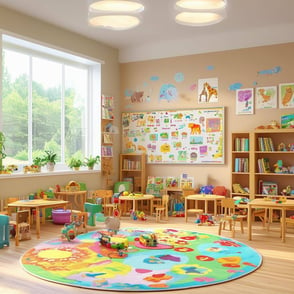Exploring the Te Whāriki Approach to Early Years Education
Te Whāriki, New Zealand's early childhood curriculum framework, is a unique and holistic approach that emphasises the importance of cultural context, family involvement, and child-led learning. Developed in the early 1990s, Te Whāriki is designed to support the diverse needs of children and their families, fostering a sense of belonging and empowerment. This blog post will explore the specifics of the Te Whāriki approach, its developmental frameworks, pedagogic principles, and notable schools in New Zealand and the UK that implement this model. Additionally, we will compare and contrast Te Whāriki with other early years specialisms, including Reggio Emilia, HighScope, Rudolf Steiner, Forest School, and Montessori, all of which were part of the original inspiration for the educational modelling in Hatching Dragons' ethos and curriculum back in 2015
History and Origins of Te Whāriki
Te Whāriki was introduced in 1996 as a response to the need for a culturally relevant and inclusive early childhood curriculum in New Zealand. The framework is rooted in Māori values and principles, reflecting the country's bicultural heritage. The name "Te Whāriki" translates to "the woven mat," symbolising the interconnectedness of children, families, and communities in the learning process.
The Woven Mat: Understanding the Essence of Te Whāriki
To truly understand the Te Whāriki Approach, one must appreciate the significance of its name: 'the woven mat'. This imagery reflects how family and community are interwoven into the fabric of a child’s learning experiences.
Grounded in early childhood education in New Zealand, Te Whāriki uses this framework to support children in their holistic approach to development by encompassing routines, customs and regular events.
By valuing play as meaningful learning , Te Whāriki cultivates curiosity and encourages children to explore their theories about how things work, fostering a lifelong love of learning.
Core Areas of Learning and Developmental Frameworks
Te Whāriki is structured around five key strands that guide children's learning and development:
- Well-being: Focuses on children's emotional and physical well-being, promoting a sense of security and belonging.
- Belonging: Emphasises the importance of relationships and connections with family, community, and culture.
- Contribution: Encourages children to participate actively in their learning and contribute to their communities.
- Communication: Supports language development and effective communication skills through various forms of expression.
- Exploration: Promotes curiosity and inquiry, allowing children to explore their environment and engage in hands-on learning experiences.
Principle Pedagogic Principles
Te Whāriki is guided by several key pedagogic principles that shape its teaching and learning practices:
- Child-Centered Learning: The approach prioritises the interests and needs of the child, allowing them to take an active role in their learning.
- Cultural Relevance: Te Whāriki recognises the importance of cultural identity and values, incorporating Māori perspectives and practices throughout the curriculum.
- Holistic Development: The framework supports the whole child, addressing emotional, social, cognitive, and physical development.
- Partnerships with Families: Te Whāriki emphasises the importance of collaboration between educators and families, fostering strong relationships that support children's learning.
Notable Schools Implementing Te Whāriki
In New Zealand, many early childhood centers implement the Te Whāriki framework effectively. Some notable institutions include:
- Te Kōhanga Reo: These Māori language immersion centers focus on preserving and promoting Māori culture and language through the Te Whāriki framework.
- Kindergarten Association: Many kindergartens across New Zealand incorporate Te Whāriki principles, providing a play-based learning environment that supports children's development.
Comparing Te Whāriki with Other Early Years Specialisms
When exploring early childhood education, it's essential to compare Te Whāriki with other methodologies. Here’s how it stands against some well-known approaches:
Reggio Emilia
Both Te Whāriki and Reggio Emilia emphasize child-led learning and the importance of community and family involvement. However, Reggio Emilia places a stronger focus on project-based learning and the role of the environment as a teacher, while Te Whāriki is more explicitly rooted in cultural context and biculturalism.
HighScope
HighScope and Te Whāriki both prioritize active learning and child agency. However, HighScope employs a structured plan-do-review process, while Te Whāriki offers a more flexible framework that allows for a broader range of learning experiences based on children's interests.
Rudolf Steiner
Te Whāriki and Rudolf Steiner both emphasize holistic development and the importance of creativity in learning. However, Steiner education incorporates a structured curriculum with a focus on rhythm and routine, while Te Whāriki is more flexible and culturally responsive.
When compared to Forest School, which prioritises outdoor learning, Te Whāriki offers a balanced approach that includes both indoor and outdoor experiences, fostering exploration in various environments. Lastly, while Montessori shares a focus on child-led learning, it relies on specific materials and a prepared environment, whereas Te Whāriki encourages a broader range of experiences based on children's interests and cultural contexts.
In summary, Te Whāriki stands out for its strong emphasis on cultural relevance and community involvement, making it a unique and effective framework for early childhood education.
How Te Whāriki Supports Children to Learn and Grow
At its core, Te Whāriki is designed to support children to learn and grow by placing them at the center of their educational journey.
This approach to early years values play is valued as meaningful learning and encourages children to learn through responsive exploration.
This means that learning experiences are shaped by the child's interests and needs.
Moreover, Te Whāriki's commitment to cultural relevance, particularly its grounding in Māori values, ensures that children develop a strong sense of identity and connection to their family and community, which further enhances their ability to learn and grow.
Why Te Whāriki Focuses on the Child and Family
Te Whāriki's commitment to focuses on the child and family stems from the belief that children learn and grow best when their individual needs and interests are at the forefront.
This approach to early years prioritizes child-centered learning, empowering children to take an active role in shaping their own learning experiences. Furthermore, Te Whāriki recognises the vital role of family and community in a child's development, fostering strong partnerships with families to ensure a cohesive and supportive learning environment.
How Te Whāriki uses learning experiences to support children?
Te Whāriki's five core strands – Well-being, Belonging, Contribution, Communication, and Exploration – are interwoven to create rich learning experiences that support children's holistic development.
Each strand contributes to the child's overall growth, fostering a sense of security and belonging, encouraging active contribution to their community, promoting effective communication skills, and nurturing a spirit of curiosity and exploration.
Through these interconnected experiences, Te Whāriki ensures that children to learn and that each child's unique potential is nurtured.

31-Dec-2024 18:55:23
Related Articles





Write a Comment